by Lisa Cooke | Jun 9, 2017 | 01 What's New, Craft & Displays, DNA, Gifts
Just in time for Father’s Day! This new DNA ethnicity chart design is a classy and cutting-edge way to share your family history. As wall displays, this is the perfect conversation-starter for your home or heritage gift for a loved one.
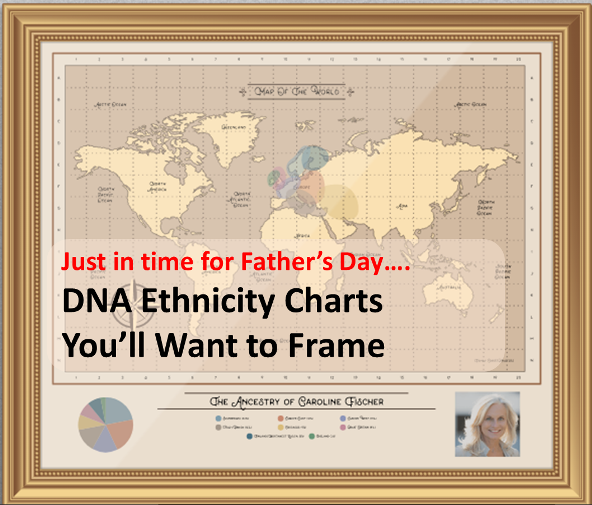
There’s a gorgeous new way to display your genetic genealogy from Family ChartMasters! It’s a new custom DNA ethnicity chart, and it’s a fantastic way to spark conversation about your family history with friends and loved ones.
“At Family ChartMasters we believe that family history can save the world,” says owner Janet Hovorka. “The more people know about their background, the more they are inspired with civility, gratitude and compassion for other people because they find out we are all more alike than different. We want to help people make that easy to remember every day.”
Your ethnic “pie chart”
 DNA ethnicity results–those “pie charts” that come with your genetic genealogy test results–are one of the most popular aspects of testing. Even those without an active interest in researching their roots often test just to learn what their DNA says about their genetic roots: How Irish are they? Do they have Jewish roots? Is there any truth to that old family story about being descended from an Indian princess?
DNA ethnicity results–those “pie charts” that come with your genetic genealogy test results–are one of the most popular aspects of testing. Even those without an active interest in researching their roots often test just to learn what their DNA says about their genetic roots: How Irish are they? Do they have Jewish roots? Is there any truth to that old family story about being descended from an Indian princess?
The science behind DNA ethnicity percentages is still being refined, as is evident from the varying ethnicity results you may receive from different companies. But it’s still fascinating to learn–and super shareable with just about anyone!
DNA ethnicity chart options
Family ChartMaster’s new DNA ethnicity chart comes in three themes to fit a variety of different décor styles: Basic, Antique, and Modern. The Basic theme is clean and fresh, and complements most decorating styles. The Antique theme’s sepia-tone finish brings together the styling of antique maps with your high-tech DNA profile. The Modern theme is graphic and bold, with neutral tones well-suited to contemporary décor.
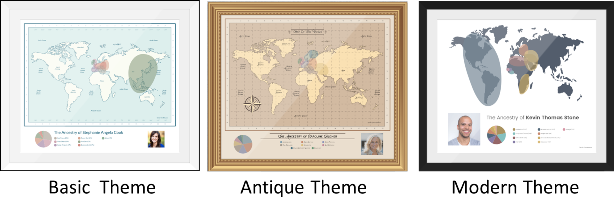
In less than five minutes, you can upload an optional photo and then manually enter your ethnicity estimates from a DNA test. The categories are currently aligned with AncestryDNA’s ethnic regions–which is running a great sale for Father’s Day, by the way, if you’ve been waiting to purchase a test. (Other DNA test providers also have some great prices now; click here to see them.)
After viewing a preview of your DNA ethnicity chart, you can place an order that can be printed on archival Professional Paper or Artist’s Grade Canvas. Following Family ChartMasters’ proven track record of superior service, the beautiful print will arrive rolled in a tube and ready to frame. You can also order PDF downloads for immediate delivery to an email inbox. Pricing starts at $19.95.
(Will your chart come in time for Father’s Day? According to the Family ChartMasters website, orders take 24-48 hours to prepare, and regular shipping takes 2-3 days within the U.S. Faster shipping options are available for an additional charge. If in doubt, order the PDF download.)
These DNA ethnicity charts are perhaps the easiest heritage display you’ll ever make! They also take advantage of the current widespread interest in DNA, making a conversation about your heritage more meaningful and appealing even with those who have never expressed interest in your heritage. Click here to see how to order your DNA ethnicity chart.
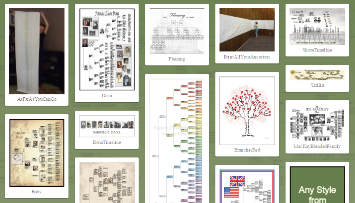 More than DNA charts: Family ChartMasters is an award-winning genealogy chart printing and design service. It is also the official printing service for most worldwide genealogy software, database, and research companies. Family ChartMasters prints any style of family history chart from any kind of file. They offer oversized draft-quality family reunion charts as well as custom decorative designs.
More than DNA charts: Family ChartMasters is an award-winning genealogy chart printing and design service. It is also the official printing service for most worldwide genealogy software, database, and research companies. Family ChartMasters prints any style of family history chart from any kind of file. They offer oversized draft-quality family reunion charts as well as custom decorative designs.
 Click below to read more about….
Click below to read more about….
Getting your DNA tested (or someone else’s)
Creating beautiful and unique heritage displays
by Lisa Cooke | Jan 9, 2017 | 01 What's New, DNA |
As genealogists, we spend our time trying to ferret out the real story in our family’s oral history, or at least from the records they left behind. Record research is critical, but now we have an amazing new tool…DNA matching.

Genealogists constantly check family stories against the information on records, searching for what sounds plausible and what doesn’t. Even when we have total agreement in our records, more information often comes along…like DNA testing. In fact, DNA matching may shed light on even more apparent discrepancies.
Family Lore vs. DNA Findings
I recently read an article in the Wall Street Journal about a reporter, Cameron McWhirter, who shared finding that kind of discrepancy between his family lore and his DNA. He even goes so far as to say, “I am descended, at least partially, from liars.” He makes the point, “many immigrants reinvented themselves when they arrived here (the United States).” This could be a nice way of saying they had a chance to invent a new legacy, not just re-invent it. His assessments were certainly interesting and worth reviewing. It helps us see how DNA testing can affect the way we look at our family stories and traditional research results.
McWhirter may be like some folks today who have never set foot inside a courthouse or scanned through microfilm, but instead relies heavily on internet research. Some of these modern genealogists never gave their family history a second thought until, like McWhirter, the death of parents started to inspire them to dig deeper. Due to the large volume of information online, the budding genealogist is “quickly pulled into the obsessive world of modern genealogical research.”

Example of an ethnicity report from Ancestry.com.
McWhirter’s personal story was that while his dad was proudly and solidly a self-proclaimed Scot, the records and DNA matching revealed his heritage was actually from Ireland and eastern Europe. McWhirter says that his “father hated Notre Dame, but judging by my results he could have been one-quarter to one-half Irish. He spoke dismissively of people from Eastern Europe, but part of his genetic code likely came from that region.”
McWhirter’s evaluation of his genetic report includes only his ethnicity results, which as you can hear, were meaningful to him in the way that flew in the face of his father’s prejudices and assertions of his own identity.
However, the ethnicity results fall short of the point of testing for most genealogists.
He has the opportunity to more powerfully transform his sense of family identity by taking a look at his match list. Here, he may see an actual living cousin who was also descended from his German great-grandmother, who maybe never mentioned that she was also Jewish.
The Real Goal: DNA Connections to Living Family
Connecting with other cousins who also have paper trails to our ancestors serves to provide further confidence that we have put all the pieces together and honored the right ancestor with a spot on our pedigree chart. We multiply our own research efforts by finding more people like us—literally—who are descended from the same people. As long as they are as diligent in their research as we are, we can make these connections that could finally bust through those genealogy brick walls and more.
At a recent conference, I met a fifth-cousin. Even with a connection that distant, it was exciting and it encouraged us to want to look again at our connecting ancestors. To me, that is the bigger picture and the real goal—when the paper trail comes together with the DNA results and turns into real live cousins.
The Next Step: Using Your DNA Results to Find Living Family
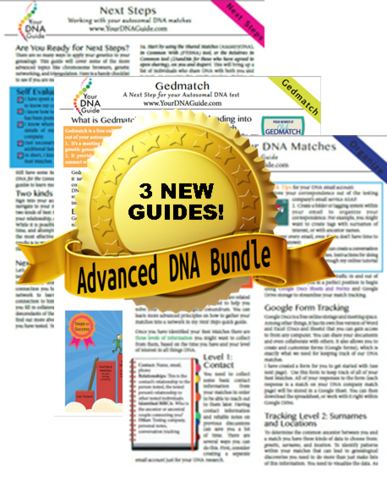 Maybe you are like Cameron McWhirter: you’ve taken a DNA test, been intrigued or disappointed by the ethnicity results, but haven’t fully explored your matches on your list. You may be seriously missing some opportunities! If that is you, I have written my new DNA quick guide just for you. It’s called “Next Steps: Working with Your Autosomal DNA Matches.” This guide will teach you how to leverage the power of known relatives who have been tested. You will get an intro to chromosome browsers and their role in the search process and access to a free bonus template for evaluating genealogical relationship of a match to the predicted genetic relationship. This guide also gives you a methodology for converting unknown relatives on your match list into known relatives.
Maybe you are like Cameron McWhirter: you’ve taken a DNA test, been intrigued or disappointed by the ethnicity results, but haven’t fully explored your matches on your list. You may be seriously missing some opportunities! If that is you, I have written my new DNA quick guide just for you. It’s called “Next Steps: Working with Your Autosomal DNA Matches.” This guide will teach you how to leverage the power of known relatives who have been tested. You will get an intro to chromosome browsers and their role in the search process and access to a free bonus template for evaluating genealogical relationship of a match to the predicted genetic relationship. This guide also gives you a methodology for converting unknown relatives on your match list into known relatives.
So check it out, either by itself or as part of my Advanced DNA bundle, which comes along with my new Gedmatch guide and a guide expressly for organizing your DNA matches.
by Lisa Cooke | Jan 7, 2015 | 01 What's New, Adoption, Book Club, History
The Genealogy Gems Book Club debuted to excellent response from you, our readers and listeners and social media followers! A LOT of you are passionate about books and family history!
Our last title was a memoir by a woman raised in England who told a story about her South African roots. So what’s the new book? Well, we’re going to cross the sea–and genres–to a novel by U.S. author Christina Baker Kline.
 Orphan Train
Orphan Train spent five weeks at the #1 spot on the New York Times Bestselling list. When you read it you’ll see why. Here’s the storyline:
spent five weeks at the #1 spot on the New York Times Bestselling list. When you read it you’ll see why. Here’s the storyline:
Vivian is an Irish immigrant child who loses her family in New York City and is forced to ride the ‘orphan train.’ Orphan trains were a common solution in the late 1800s and early 1900s for care of abandoned or orphaned children in New York City and other places. The children were loaded onto trains and paraded in front of locals at various stops across the countryside, where they might be claimed by just about anyone.
After following Vivian’s life through her childhood and young adulthood, we fast-forward. Vivian is 91, and a teenage girl named Molly comes to help her clean out her attic. Molly is a Penobscot Indian who is in the modern foster care system. Gradually they realize they have a lot in common, and you’ll love the ways they each respond to that.
Why did I choose this book for family history lovers to read? To me, the book is about the importance of family identity. Each of us has a family storyline that existed before we were born and brought us into being. Vivian’s and Molly’s experiences remind me how important it is to know and value our family backgrounds. Of course I loved learning more about orphan train riders, too. That chapter of history is now a vivid reality to me.
Click here to order your copy of Orphan Train
When you initiate your purchase here, you are helping support the FREE Genealogy Gems podcast and the Book Club, whether you choose an e-book, or new or used print book on Amazon. Thank you! Then stay tuned–we’ll chat a little more about the book in the February podcast and the author herself will join us in March for an exclusive interview.
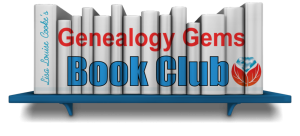 Click here to learn more about the Genealogy Gems Book Club and to see books we’ve featured in the past.
Click here to learn more about the Genealogy Gems Book Club and to see books we’ve featured in the past.
by Sunny | Apr 7, 2018 | 01 What's New, Genealogy TV
Relative Race season 3 is still going strong. Are you watching this family-friendly reality TV series? It’s also family-history friendly! If you haven’t tuned in yet, consider catching up by watching free episodes you’ve missed. Check details here...
by Lacey Cooke | Dec 3, 2018 | 01 What's New, Ancestry, DNA |
Get a new perspective on your DNA results with AncestryDNA’s new Genetic Traits feature. For just $10, you can discover how traits run in your family and might even come from ethnic origins, with no additional DNA test needed. It’s a deeper look into what...

 DNA ethnicity results–those “pie charts” that come with your genetic genealogy test results–are one of the most popular aspects of testing. Even those without an active interest in researching their roots often test just to learn what their DNA says about their genetic roots: How Irish are they? Do they have Jewish roots? Is there any truth to that old family story about being descended from an Indian princess?
DNA ethnicity results–those “pie charts” that come with your genetic genealogy test results–are one of the most popular aspects of testing. Even those without an active interest in researching their roots often test just to learn what their DNA says about their genetic roots: How Irish are they? Do they have Jewish roots? Is there any truth to that old family story about being descended from an Indian princess?
 More than DNA charts: Family ChartMasters is an award-winning genealogy chart printing and design service. It is also the official printing service for most worldwide genealogy software, database, and research companies. Family ChartMasters prints any style of family history chart from any kind of file. They offer oversized draft-quality family reunion charts as well as custom decorative designs.
More than DNA charts: Family ChartMasters is an award-winning genealogy chart printing and design service. It is also the official printing service for most worldwide genealogy software, database, and research companies. Family ChartMasters prints any style of family history chart from any kind of file. They offer oversized draft-quality family reunion charts as well as custom decorative designs. Click below to read more about….
Click below to read more about….




